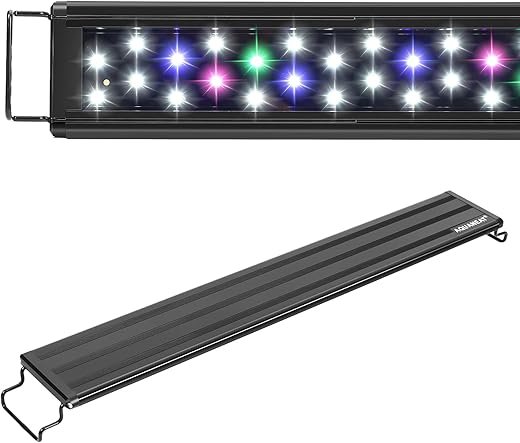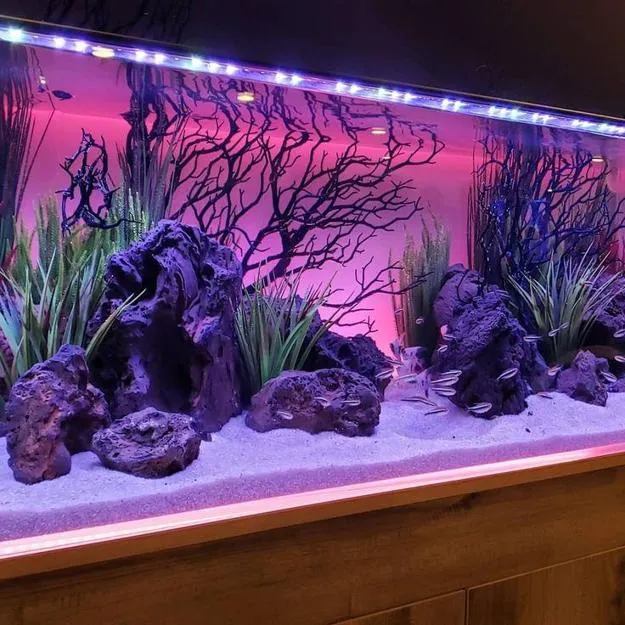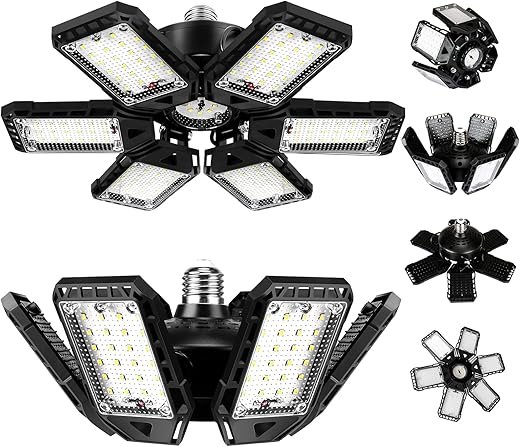This step-by-step guide provides an overview of how to effectively use LED lights to promote plant growth in aquariums. It highlights the advantages of LED lighting, including its efficiency and ability to customize the light spectrum and intensity, which are crucial for enhancing the health and growth of aquatic plants. By following the instructions in this guide, aquarists can optimize their aquarium setup to create an ideal environment for thriving aquatic vegetation.


Blue Night Lights Promote Algae Growth. #aquariumcoop
1. Choose the Right LED Lights
Select LED lights specifically designed for aquarium use to ensure the health of your aquatic environment. Look for products that advertise a full spectrum of light, emphasizing the inclusion of blue and red wavelengths, as these are critical for photosynthesis in aquatic plants. Check the packaging for information on light spectrum and intensity, ensuring it meets the needs of both fish and plants in your aquarium. Consider adjustable brightness options to accommodate different species and plant types, providing the optimal light conditions for growth and well-being.
2. Determine Light Intensity
- Assess the light intensity needed based on the types of plants you have.
- Identify if your plants are low-light or high-light varieties.
- Allocate low-light plants 30-60 micromoles of light per square meter per second, as they thrive in softer lighting.
- Provide high-light plants with stronger lighting to meet their growth requirements, typically exceeding 60 micromoles.
- Measure the light intensity using a photon meter to ensure your plants receive adequate light.
- Adjust the distance of the light source from the plants to fine-tune the intensity based on your measurements.
3. Position the Lights Correctly
- Install the LED lights at a height of 6-12 inches above the water surface. This height ensures that the light penetrates the water evenly, promoting healthy plant and fish growth.
- Adjust the height based on the specific needs of your aquarium inhabitants. Monitor the response of plants and fish to the light and make necessary adjustments to avoid excessive algae growth.
- Use adjustable mounting brackets or hanging kits for flexibility in positioning the lights. This allows for easy modifications as your aquarium’s ecosystem evolves.
- Ensure that the lights are securely fastened to prevent any accidental falls or disturbances that could harm the aquarium’s environment.
4. Set the Light Duration
Establish a consistent lighting schedule. Aim for 8-12 hours of light each day. This duration mimics natural sunlight patterns, which is crucial for effective photosynthesis.
- Set a timer for your grow lights to ensure they turn on and off at the same time daily.
- Adjust the duration based on your specific plants’ needs; for example, leafy greens may thrive with 10-12 hours, while succulents may require only 8-10 hours.
- Monitor plant growth and health; if you notice stunted growth or excessive algae, reconsider the light duration and make adjustments as needed.
5. Consider Using a Timer
Set up an automatic timer for your grow lights.
- Choose a timer that allows you to program specific on and off times.
- Program the timer to provide 12-16 hours of light daily, depending on the plant species.
- Plug the grow lights into the timer and ensure it is connected to a power source.
- Regularly check the timer settings to maintain consistency in your lighting schedule.
By following these steps, ensure your plants receive the optimal amount of light for robust growth and health.
6. Monitor Water Quality
Regularly check the water parameters by using a reliable water testing kit. Measure the temperature to ensure it remains within the ideal range for your plants. Test the pH levels and adjust them as necessary to maintain a balanced environment. Monitor nutrient levels and add fertilizers as needed to support healthy plant growth and enhance the effectiveness of your LED lighting.
7. Adjust Lighting Based on Plant Response
- Observe your plants closely. Look for signs of stretching, which can indicate they are reaching for light, or discoloration, suggesting they may be receiving too much or too little light.
- Assess the overall growth pattern. Healthy plants should maintain a compact shape with rich, vibrant colors.
- Adjust the light intensity if you notice leggy growth or pale leaves. Move the light closer for more intensity or further away if it’s too harsh.
- Modify the duration of light exposure based on your observations. If plants are stretching, increase the light duration gradually, or reduce it if they appear scorched or bleached.
- Regularly check your plants after making adjustments. Monitor their growth and coloration to ensure the changes positively impact their health.
8. Incorporate CO2 Injection
Increase CO2 levels in your aquarium by installing a CO2 injection system, especially if you are utilizing high-intensity lighting. Monitor your plants closely; when they receive additional CO2, you will notice enhanced growth rates and improved overall health. Consider using a CO2 diffuser to evenly distribute the gas throughout the tank, ensuring all plants benefit from the enriched environment. Adjust the injection rate according to your lighting schedule, as higher light intensity will require more CO2 for optimal plant performance.
9. Perform Regular Maintenance
Clean LED lights using a soft, damp cloth to remove dust and dirt that can reduce light output. Inspect the area around your lights for any obstructions such as leaves or other objects that may block the light from reaching your plants. Adjust or trim any foliage that interferes with the light’s path, ensuring maximum exposure. Regularly check and maintain these elements to promote optimal light penetration and create ideal growth conditions for your plants.
10. Observe and Adjust
Monitor the health of your plants regularly by checking for signs of yellowing leaves, stunted growth, or algae blooms. Assess the aquarium environment by measuring water parameters such as pH, ammonia, nitrites, and nitrates. Adjust lighting levels based on the specific needs of your plants; increase or decrease the duration and intensity of light as necessary. Modify water conditions by performing partial water changes or adding appropriate fertilizers to support plant growth. Experiment with different plant species if certain plants are not thriving, selecting varieties that are compatible with your existing conditions.
Maximizing Growth Potential
In conclusion, utilizing LED lights to promote plant growth in aquariums is a practical and effective approach. By carefully selecting the appropriate lighting, fine-tuning the intensity and duration, and ensuring optimal environmental conditions, you can create a vibrant and flourishing aquatic habitat. With these strategies, not only will your plants thrive, but your entire aquarium ecosystem will benefit, leading to a more balanced and visually appealing underwater landscape. Happy planting!
Essential Equipment List
- LED grow lights
- Light meter
- Adjustable light mounts or brackets
- Timer
- CO2 injection system
- Water testing kits
- Aquarium substrate
- Fertilizers for aquatic plants
- Aquarium maintenance tools (net, siphon, etc.)
- pH and nutrient test strips

Maximize Your Growth
- Choose the Right Spectrum: Use full-spectrum LED lights that emit a balanced combination of blue and red wavelengths, as these are most effective for photosynthesis
- Adjust Light Duration: Aim for a light cycle of 10-12 hours per day to mimic natural sunlight and promote healthy plant growth
- Positioning Matters: Place the LED lights at an appropriate height above the aquarium to ensure even light distribution without causing overheating
- Monitor Light Intensity: Adjust the intensity of the LEDs based on the plant species’ requirements; some plants thrive in low light while others need high light
- Use Dimmable LEDs: Consider dimmable LED options to fine-tune light levels according to plant growth stages and specific needs
- Implement Co2 Supplementation: Enhance the effects of LED lighting by supplementing CO2, which can significantly boost plant growth
- Regularly Clean the LEDs: Keep the LED lights clean and free from algae or dust to maintain optimal light penetration
- Consider Light Positioning for Plant Types: Position lights closer to plants that require more light and further away from low-light species to prevent overstimulation
- Rotate Light Sources: For larger tanks, rotate the positions of the lights periodically to ensure all plants receive equal light exposure
- Observe Plant Response: Monitor growth and health of the plants regularly, and adjust lighting conditions based on their responses
Subheading: “Maximizing the Benefits of LED Lighting for Your Aquarium
- Choose the Right LED Light: Select an LED aquarium light that suits the size of your tank and the types of plants or fish you have. Look for options specifically designed for aquariums to ensure proper spectrum and intensity
- Positioning the Light: Place the LED light above the aquarium, ensuring it covers the entire tank evenly. For larger tanks, consider multiple lights or adjustable fixtures to eliminate dark spots
- Set a Lighting Schedule: Use a timer to establish a consistent lighting schedule, typically 8-12 hours a day, to mimic natural day/night cycles for your aquatic life and plants
- Adjust Brightness and Color Temperature: Experiment with different brightness levels and color temperatures to create a suitable environment for your fish and plants. Many LED systems have adjustable settings for optimal growth and appearance
- Regular Maintenance: Clean the LED lights regularly to prevent algae buildup and ensure maximum light penetration. This will help maintain a healthy aquarium environment
Illuminate Your Aquarium: Common Questions About LED Lighting
How can I determine the right intensity of LED light for my specific aquarium setup?
To determine the right intensity of LED light for your specific aquarium setup, consider the following factors:
- Type of Aquarium: Freshwater, saltwater, and planted tanks have different lighting needs. For instance, planted tanks typically require higher light intensity than fish-only tanks.
- Depth of the Tank: The depth of your aquarium will affect how much light penetrates the water. Deeper tanks may require more intense lighting to ensure that light reaches the bottom.
- Light Spectrum: Different species of plants and corals thrive under specific light spectrums. For planted tanks, a full spectrum light (including red, blue, and green wavelengths) is often beneficial, while reef tanks may require more blue light to support coral growth.
- Light Duration: The length of time lights are on each day also impacts intensity. Most aquariums benefit from 8 to 12 hours of light per day, depending on the needs of the organisms inside.
- PAR Measurements: Use a Photosynthetically Active Radiation (PAR) meter to measure the light intensity in micromoles per square meter per second (µmol/m²/s). Different aquatic plants and corals have specific PAR requirements. Generally:
- Low light: 20-50 µmol/m²/s
- Moderate light: 50-150 µmol/m²/s
- High light: 150+ µmol/m²/s
- Type of LED Fixture: Different LED fixtures have varying intensity outputs. Check the manufacturer’s specifications and reviews to understand the expected light output.
- Aquascape and Plant Selection: The types of plants or corals you intend to keep will dictate light requirements. Research specific species to determine their lighting needs.
- Trial and Adjustment: Start with a moderate intensity and adjust based on plant growth and health, as well as any signs of algae growth, which can indicate excess light.
By considering these factors and possibly consulting with aquarium professionals or communities, you can determine the appropriate LED light intensity for your aquarium setup.



